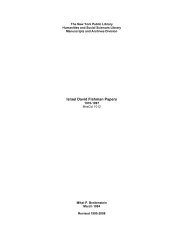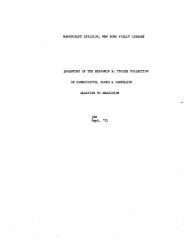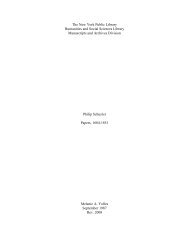pdf available - Multiple Choices
pdf available - Multiple Choices
pdf available - Multiple Choices
You also want an ePaper? Increase the reach of your titles
YUMPU automatically turns print PDFs into web optimized ePapers that Google loves.
killed there. In spite of the danger, a few Jews<br />
went to the cemetery in order to make sure, and<br />
there they found a large grave and discovered the<br />
victims.<br />
A special incident was the cutting of the<br />
beards. Jews were caught and their beards forcibly<br />
cut; most were pulled out by the roots. Not<br />
three weeks went by and another "hunting party"<br />
went out. In three days, 300 men and women were<br />
summarily arrested and taken to an unknown destination.<br />
But it soon was known that all 300 souls<br />
were murdered in the Borki forest (a place where<br />
the Jews of Luboml had often gone hiking), and<br />
there they were buried.<br />
Again a new edict: to concentrate in a ghetto,<br />
formed from a part of the street that led to the<br />
railroad, for those who were still physically strong<br />
and could workthey received "red" certificatesand<br />
Brisk Street for the rest of the Jews.<br />
Everyone was forced into this section of the city<br />
even though the buildings had been damaged in<br />
the fire and there were those who lived 15 to a<br />
MOM.<br />
There were no barbed-wire fences as in<br />
other ghettos, but sentries were posted to see<br />
that no one got out. Those who went out of the<br />
ghetto to work were accompanied by guards<br />
and were brought back into the ghetto after<br />
work, tired and depressed. The Jews were<br />
careful not to leave the ghetto. The Germans<br />
ordered that we prepare provisions for the<br />
transfer to the ghetto, and every Jew bought<br />
food and supplies with whatever money he<br />
had left. The following day, the Germans sent<br />
the Ukrainian police, who searched and found<br />
the foodand confiscated it.<br />
One day, while conducting a search, the<br />
Germans accidentally found in the Great Synagogue<br />
the Purim Megillah in its black holder, and<br />
they defamed it, saying: "This is probably a list<br />
of curses against the Fuhrer." All the explanations<br />
by the Jews were to no avail and the order<br />
went out to burn all Torah scrolls, along with the<br />
Megillah. Fifty young women were made to bring<br />
the Torah scrolls out into the street and burn<br />
them under the watchful eyes of the Germans<br />
and the Ukrainian police. On that autumn day,<br />
there was a strong wind, and the Ukrainians who<br />
THE ANNIHILATION 277<br />
witnessed it said it was the anger of God for the<br />
burning of the Holy Scriptures.<br />
For over a year the Germans forced the Jews<br />
to work in the lumber mill, in building the railroad,<br />
in the forests and in digging trenches, etc.<br />
Jews were hitched to wagons like horses and<br />
forced to drag heavy loads from warehouses, the<br />
flour mills, etc. Food was given to the workers<br />
grudginglya half-pound of bread daily, a quart<br />
of milk a week. It was forbidden to buy anything<br />
from the farmers.<br />
There was no limit to the extreme brutality of<br />
the conquerors. For instance, when a Ukrainian<br />
woman was caught with a chicken and was<br />
forced to reveal which Jew it was for, she told<br />
them the name of a hat-maker she knew-<br />
Nachman Shtreicher the hat-maker, a father of<br />
seven childrenand he was arrested and killed.<br />
When the three daughters of Meyer Melamed and<br />
Dovid Melamed who worked on the railroad<br />
were caught while exchanging kerchiefs for bread<br />
and milk [and eggs; see previous story), they were<br />
arrested and sentenced to death. These sentences<br />
were posted publicly. Jews were forbidden to come<br />
in contact with Christians.<br />
In the area near the brickworks outside the<br />
town, piles of clay that had been dug grew higher<br />
and higher. The Jews were placed between these<br />
to dig the pits even deeper, and an engineer<br />
would come to measure the results. The Jews<br />
were afraid and suspected these pits were going<br />
to become their graves, but those who oversaw<br />
the work denied this, and the authorities, who<br />
were always "receiving" nice presents, promised<br />
that nothing bad would happen.<br />
In the days between Rosh Hashana and Yom<br />
Kippur of 1942, there was a lot of talk in the<br />
ghetto about a final round-up, on a large scale.<br />
Young people found ways of getting weapons<br />
from Ukrainian youths, prepared bunkers, tried to<br />
get food that was almost nonexistent and, most<br />
importantly, tried to protect lives. And this was<br />
not in vain. Members of the Judenrat went to the<br />
commissar with "presents," among them an inlaid<br />
menorah, in order to appease him, and they<br />
tried to find out the meaning of the pits, etc. He<br />
received those presents and dismissed the fears of<br />
the Jews, explaining the pits were for clay and that







